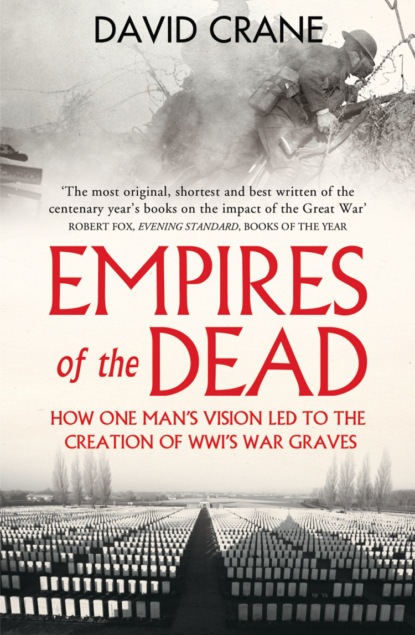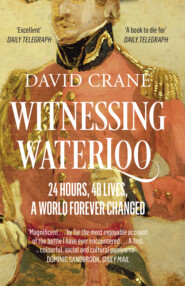По всем вопросам обращайтесь на: info@litportal.ru
(©) 2003-2024.
✖
Empires of the Dead: How One Man’s Vision Led to the Creation of WWI’s War Graves
Автор
Год написания книги
2018
Настройки чтения
Размер шрифта
Высота строк
Поля
Although in some ways the new GRC remained a curiously hybrid, semi-detached sort of unit – the Red Cross continued to supply men and vehicles, while Ware was given the local rank of major (with two captains and seven lieutenants under him) and the Army took on the costs of crosses, rations and fuel – the crucial thing for Ware was that the GRC had the monopoly he had wanted. In the first months of the war he been obliged to share power with the Red Cross’s Paris office, and with Macready now behind him, he moved swiftly and ruthlessly to take control of the work being done in the Aisne/Marne district by Ian Malcolm and bring it under a single unified command.
He was right to do what he did – unauthorised individuals had become involved, vital identification evidence removed, questionable exhumations carried out – but it was unmistakably the old Ware of South Africa and Morning Post days who had ruthlessly squeezed out Spenser Wilkinson. In the earliest days in France he had often found the Red Cross were actually ahead of him in their work, and yet if Malcolm imagined now that that would count for anything he was in for a sad awakening. ‘There is not, of course (#litres_trial_promo), much in the personal point,’ Malcolm pleaded with Lawley,
though I am bound to say I feel rather aggrieved at being completely passed over and superseded in my own area where I have worked so hard for five months [but on public grounds, to avoid replication]. Would it not, therefore, be well if the A.G., or Fabian Ware … could entrust me with their official programme? Can you not help to arrange this?
‘It would be a matter (#litres_trial_promo) of the greatest disappointment to me if all this were suddenly taken from out of my hands,’ he wrote in the same plaintive vein to Ware on 11 March, ‘and I should feel sure that it would be far from your wish that it should be so.’
He did not know his man, and within the week all his maps, lists and cemetery concessions were on the new director’s desk, as Ware began the business of putting their old grave work on a more organised footing. At the outset Ware still had all the problems of a volunteer workforce and a War Office that ‘neither cares nor understands (#litres_trial_promo)’, but by the middle of August 1915 plans had already assumed a ‘definite’ enough shape for him to be able to describe the organisation in a report to Macready that shows just why he had been the right choice for the job.
Ware had divided the Commission into two parts, with seven distinct sections to carry out the field work and a headquarters responsible for the compilation and update of two registers. The first of these was a registration of graves with the names of officers and men listed by regiment, with details of any existing cross or inscriptions where the sites were accessible, and a note of who had reported them where they could no longer be reached, along with a record of any outstanding enquiries.
The second, complementing the regimental lists, was a geographical register. ‘By means of this (#litres_trial_promo),’ Ware explained, with all the breezy confidence of a man who still did not know what lay ahead,
it is possible to state at once how many burial grounds are in existence, how many graves are in each, and in what units they belong. The register also enables crosses destroyed by shell fire or otherwise to be replaced, and it is practically impossible for any grave once located to be lost sight of.
All enquiries, half of them from France, half from home, were also dealt with at their chateau headquarters at Lillers, but the real spade-work, as it were, was carried out by the sections. In the first reorganisation Ware had envisaged that there would be four of these, but by the August of 1915 those four had swelled to seven – ‘A’ and ‘G’ at Bethune for instance, ‘D’ at Aisne and Marne – with the officer in charge of each district responsible for marking and reporting burials to headquarters, tracking down and verifying old graves, collating daily returns from chaplains, units and hospitals, and finally preparing and erecting wooden crosses with their machine-punched metal identification plates.
In tandem with this work, often carried out under conditions of great risk, as Haig noted, went a growing number of local enquiries, and the first rudimentary improvements to the appearance of cemeteries sparked off by a torrent of requests for photographs from families back in Britain. Macready had already exempted the Graves Registration Commission from the prohibition against photography, and with funds from the Joint War Committee of the Red Cross and St John Ambulance a separate department was set up and three ‘first-class’ professional photographers put to work over the summer months to begin the task of photographing all the graves.
Six thousand graves photographed, 800 photographs despatched to families in England, 18,173 graves registered, it was an extraordinary workload that had been completed by the middle of August. However there was a limit to what even Ware could do. In the first days of the GRC he had wanted the old Mobile Unit to continue its ambulance duties, but with his resources stretched to the limit by the expanding GRC work it was probably as well that a rare breakdown in his relations, and an even rarer show of offended dignity from Ware, forced his hand.
It was a sad end to a fertile partnership, but it cleared the way for Ware to concentrate on his graves work. It also foreshadowed another equally inevitable development in the story of the GRC. Macready and the Old Army – with memories of the chaos in South Africa – had never been entirely comfortable co-operating with the Red Cross and a change of status was needed. With the volume of work growing by the day, and a volunteer manpower inadequate to the task, the existing compromise made no sense. ‘I saw the AG (#litres_trial_promo) the other day,’ Sir Arthur Lawley wrote in mock outrage to Ware at the end of August,
who hinted at an act of Piracy so audacious that I am still dumb with horror at the mere suggestion.
He proposes to swallow at one gulp the GRC and all its merry men.
Could you ever endure to be torn from the sheltering arms of the Red Cross?
‘Now!’ I hear you say.
I will do all I can to save you.
Within weeks it was a faintaccompli. On 6 September, Macready recommended to the War Office that the GRC should ‘be placed on a proper footing as part of His Majesty’s forces’, and a month later its old hybrid existence came to an end. It marked the end of the first phase of Ware’s life work. The enduring, impressive and controversial aspects of that work – the questions of repatriation, commemoration, permanence, uniformity, imperial involvement and authority – still lay ahead but without the Mobile Ambulance Unit none of it could have happened.
‘I am sorry (#litres_trial_promo) and at the same time glad that it should be so,’ Lawley wrote again at the end of October, after the Army’s ‘piracy’ had become official,
sorry of course that we can no longer look upon your achievements as ‘our’ work and claim a share in its reflected glory; glad on the other hand that the excellent quality of your work and its value has received the flattering recognition which is manifested by the Army’s absorption of your entire organisation.
It was a rightly generous tribute to the work that had been done, and a sober recognition of what lay ahead. The war had changed and the Army with it. By the end of 1914, the four infantry divisions and the one cavalry division of the BEF who had crossed the Channel in August had almost trebled in size to a force of two armies and a cavalry corps of more than 270,000 men. By the spring of 1916 this would rise to a million and a peak in the summer of 1917 of 1,721,056 men. Already a newly arrived officer like Cameron Highlander Ian Mackay, who only reached France in the spring of 1915, could look back with a sense of awe on the achievements of the BEF at Mons and its aftermath as if they belonged to a wholly different conflict. They had been ‘marvellous’, he told his mother – the perfect answer ‘to the crokers (#litres_trial_promo) who lamented the decadence of the race. No troops in the world could have done what they have done.’
Mackay’s war, until it ended in an unmarked grave in 1917, would be very different. The romance, the pride, the glamour, the professional elan of the early days had died with the Old Army and all that was left to their successors was to endure. From the Channel coast to the Swiss border, an unbroken line of earthworks, stretching for 475 miles, marked the front line. This line would define Mackay’s experience of France as it still largely shapes the collective memory of what the war was like. It would also be the phase of the fighting that projected the work of Ware and his men on to a scale that makes the world of orchards, farms and solitary and scattered graves that Broadley and his colleagues searched in late 1914 seem to belong to an unimaginably remote past.
THREE (#ulink_38ed2714-c277-54e6-9c28-b6810e676783)
With an Eye to the Future (#ulink_38ed2714-c277-54e6-9c28-b6810e676783)
There were possibly any number of administrators who could have put the work of the Graves Registration Commission on an efficient footing in 1915, but how many could also have dealt with the political complexities and negotiation that went with it is a very different matter. In the early spring of 1915, Ware had begun talks in Paris with the French government on the status of British war graves, and over the next weeks and months he was in constant contact with the different government departments involved, assuaging cultural differences and repairing real or imagined slights with the finesse of a born diplomat and the political savvy of an old newspaperman.
There were the usual ‘us and them’ gripes – the War Office were ‘blighters’, he told Milner, and their clerks should be shipped over to the trenches for a week – but as ‘the sole intermediary (#litres_trial_promo) between the British Army in the Field and the French military and civil authorities on all matters relating to graves’ he had the complete authority he wanted. In the earliest days with the Mobile Ambulance Unit his work had inevitably been essentially reactive, but here, for the first time, was a chance to think and plan for the future on a scale appropriate to his energy and vision and to the growing magnitude of the Allies’ sacrifice.
It is impossible to do much more than guess what the Army had in mind when it placed Ware in charge of the negotiations. They knew that in Ware they had found a man with the experience and tact to smooth over difficulties, but if they imagined that they were taking on a kind of glorified Undertaker General to the Forces to put an acceptable face on Death for the benefit of a disturbed public back at home, then they had hopelessly underestimated their man.
He would certainly do that for them – no one in the history of warfare has transformed the horrors and suffering of a battlefield into oases of peace like Ware – but from early in their alliance he and the Army had different objectives in view. There was nothing stupid or blinkered about a man like Nevil Macready, but where he saw a problem Ware saw an opportunity; where the soldier and administrator simply recognised a failure in procedures that would come back to haunt the Army, the visionary saw the glimmer of an answer to all those pre-war dreams of unity and equality he had preached. One of the most intriguing questions that the history of the war graves poses, in fact, is when Ware first realised precisely what he was doing in France. There is an element of self-congratulation in the traditional accounts of the War Graves Commission that makes it all sound inevitable from the start, but if there is certainly a retrospective logic to its history that links the Mobile Ambulance Unit and its various reincarnations to the Commonwealth War Graves Commission of today, it owed as much to chance and opportunism as it did to vision or principle.
Ware was without question a visionary and idealist, but the real quality that enabled him to achieve things was an eye for the main chance, a politician’s instinct for popular movement, an intuitive sense of the zeitgeist, and at no time was that more obvious than in the summer of 1915. Over the late spring and early summer of that year there would be two decisions taken in France that were absolutely seminal to the future of Britain’s war graves, but if anyone other than Ware so much as glimpsed the implications of them or the social and political transformation they foreshadowed, then he kept very quiet about it.
Ware could not possibly have seen the future or even the full consequences of all the decisions he was taking, but then who in 1915 could be sure that there would be a future? In the popular consciousness the year forms a muted intermezzo between the high hopes of 1914 and the horrors of the Somme, but for those who lived through it this was the year of Neuve-Chapelle, German gas and Loos, of the naval and military disasters of Gallipoli, the year in which even the sinking of the Lusitania and the Armenian Massacres failed to shake Woodrow Wilson’s high-minded neutrality – the year that ended for Britain with the silent evacuation of one beaten army from the beaches of Turkey, the hopeless and disease-ravaged rump of another besieged in the Iraqi city of Kut, and any hopes of an Allied breakthrough on the Western Front looking more delusory than ever.
For Vera Brittain, for Rudyard Kipling and his wife Carrie, for the relatives of the 11,500 dead of Aubers Ridge who had died for nothing, of the 16,500 of Festubert who at least had their thousand yards to show for it, of the 43,000 lost at Loos, the greatest battle yet fought by a British army – it was the year that the world stopped and for the volunteers of 1914 it was their welcome to Erich Remarque’s universal enemy, Death. ‘The dug-outs (#litres_trial_promo) have been nearly all blown in,’ Roland Leighton, Vera Brittain’s fiancé and one of the brightest of those golden youths who had sat listening to Uppingham’s headmaster only a year before, wrote bitterly home,
and in among the chaos of twisted iron and splintered timber and shapeless earth are the fleshless, blackened bones of simple men who poured out their red, sweet wine of youth unknowing, for nothing more tangible than Honour or their Country’s Glory or another Lust of Power. Let him who thinks War is a glorious, golden thing, who loves to roll forth stirring words of exhortation, invoking Honour and Praise and Valour and Love of Country with as thoughtless and fervid faith as inspired the priests of Baal to call on their own slumbering deity, let him but look at a little pile of sodden grey rags that cover half a skull and a shin bone and what might have been his ribs, or at this skeleton lying on its side, resting, half crouching, as it fell, perfect but that it is headless … and let him think how grand and glorious a thing it is to have distilled all Youth and Joy and Life into a foetid heap of hideous putrescence!
Leighton himself would be dead by Christmas, shot through the stomach, but if this year of disillusionment and rising casualties brought home the grim paradox at the heart of Ware’s steady rise up the military ladder, that only made him the more resolved to ‘stick to it’. ‘I told you (#litres_trial_promo) in my last letter I regarded things then as on the knees of the Gods,’ he wrote to Milner at the end of April, just a week after the first gas attacks against French and French African troops north of Ypres.
‘Well the work is going well (touching wood, very well). Macready is very pleased … I am absolutely persuaded of the importance of the work out here.’
There were any number of sensitive and potentially divisive issues that fell within his new remit – cremations, exhumations, the proliferation of unauthorised private memorials – but at the centre of Ware’s negotiations was the key question of land expropriation for the burial of the Allied dead. Initially it had been possible to deal with these matters at local level, but as the cemeteries and churchyards immediately behind the front line filled, the problem of acquiring new land and establishing rights over old burial grounds had become a matter for the state and not the municipality. The kindness and gratitude of the French people had been a constant theme of Ware’s early letters and reports, and in the crisis summer of 1915 their government followed suit with an inimitably Gallic elan, claiming for France not just the duty but the right ‘to adopt as her child and to honour … every soldier who has fallen on her soil for justice and the freedom of the nations’. It would be the best part of a year before Ware’s negotiations finally bore legislative fruit in an ‘expropriation bill’, but in all the complex and often fractious wartime dealings of the Allies, it would be hard to find a more signal act of friendship and imagination than France’s response to the British dead.
There would be difficulties and frustrations ahead, delays and amendments in the bill’s committee stage, rumblings in the Senate, legal questions and unease over the effective appropriation of French land by a foreign government, but Ware was at least determined to make sure that his own side did not make things worse. ‘I have warned the Press (#litres_trial_promo) to tell their correspondents to be on the lookout for M. Millerand’s speech,’ he wrote to his deputy Captain Messer at a crucial stage at the end of June, when the French Minister of War was ready to move the bill, convinced, as ever, that if he did not tell people what to say and when to say it, then no one – not the Army, the Paris Embassy, the politicians at home, the newspapers, not even the Royal Family – could be trusted to do or say the right thing at the right time, ‘and I have also been privately promised that the Prime Minister will make a suitable reply in the House of Commons to M. Millerand.’
Could the Adjutant General put some pressure on the Embassy to be a little more gracious? Could a telegram of thanks from the King be sent at the right time? Could Britain not be more generous with her decorations to French civilians? It was the old Ware of the Morning Post again, prodding and cajoling, dropping a ‘hint’ to the Times editor here, soothing a minister’s vanity there, and if there was a touch of megalomania in it all, it clearly worked. By September, Millerand’s bill had been carried through the Chamber of Deputies on the back of an emotional appeal from the Rapporteur, and in December at last became law in a form that enshrined all the most disinterested intentions of the original bill with the addition of one crucial clause that would give Britain control over the future upkeep of its war graves.
Ware never did anything more important in his life and that last clause had a lot to do with it. ‘The law of 29 December’ was all and more than he could have hoped for – ‘perpetuity of sepulture’ for Britain and her Empire’s dead, the cost of all lands to be borne on the French budget, but it was this last provision for a single ‘properly constituted’ British authority to supervise and finance the maintenance of the cemeteries that proved the key to their enduring character.
It would be hard to exaggerate the importance of this provision and difficult to imagine what Britain’s war cemeteries would have looked like without it, because in relieving France of the financial burden of their maintenance, Ware had secured control over every detail of their future. At this stage of the conflict it remained a largely theoretical concern of course, but the concession guaranteed that when the time came there could be no conflicts of authority over decisions that up until this point had been matters of chance and private initiative.
It would be hard to say who Ware saw as the principal danger to this future – British units who seemed bent on turning France into a giant memorial park or French advocates of giant ossuaries – but another issue had already underlined how vital that control was. In the early months of 1915 the rising numbers of unidentified dead had presented the French authorities with an almost insuperable problem, and in the middle of June, a scientific committee set up to explore alternatives to burial, had released a report that had sent Ware scuttling around the Ministries of the Interior, War and Hygiene in panic.
The solution proposed by the committee was for a continuous chain of pleinair crematoria, a hundred metres square in size, and sited between the front line and the artillery parks at ten-kilometre intervals along the whole length of the front. Around the perimeter of each area the committee had recommended that a portable canvas screen two metres high should be erected, and at the centre of the field a large pit dug in the shape of an inverted and truncated pyramid that could be layered for cremations – ‘in the simple manner of Indians’, the report adds with an engagingly Rousseau-ian note – with successive strata of wood and naked bodies. Fifty crematoria in all, petrol or tar to expedite the process, ready access to wood and transport, twenty-five gravediggers to each site, twenty woodsmen, twenty carriers, one doctor, one engineer officer, several NCOs, one priest and, ‘if possible’, one rabbi ‘to provide for the satisfaction of every religious sentiment’: death on an industrial scale met death as gloire in a final exhortation that blended French swank, Enlightenment rationalism and a proto-Nazi thoroughness in a way peculiarly designed to disquiet John Bull.
‘In all ages (#litres_trial_promo) from the earliest times up to our own day cremation has been practised in time of war,’ the report had declared,
The hot weather is approaching. It is in the spring that epidemics develop with the greatest vigour … Myriads of worms swarm in the corpses … myriads of flies will alike sow those germs of death sprung from the dead … Great evils need great remedies. We have only just time to act …
Soldiers sacrificed their lives without hesitation. They behaved like heroes. But with the sacrifice of their lives let them and their relatives sacrifice their bodies also. Let us honour them as the ancients honoured their heroes by burning their bodies and thus rendering their cinders imperishable. The whole of the country will be their tomb. Let us free ourselves from the prejudice of the old customs which under existing conditions may be fatal … Let us not shrink from any sacrifice for those who fight.
It was a proposal that in the end died of its own technocratic afflatus, but Ware’s negotiations had crucially guaranteed that no similar threat hung over the future of Britain’s war cemeteries. The liberality of the French authorities had made some kind of settlement a formality from the start, but it was Ware who had created a treaty that would be a model for every subsequent agreement, Ware who had picked his way through the legal obstacles, Ware who had the tact and journalistic nous to mobilise establishment opinion, Ware who protected France from an uncontrolled rash of British monuments and – above all – Ware who had the foresight to recognise cultural differences in attitudes to the dead that all the Francophilia in the world was never going to bridge.
If the law of 29 December shows one side of Ware, however, the second seminal development that makes 1915 the crucial year in the history of Britain’s war graves shows the other, opportunistic side of his character. In the early months of the war a number of private exhumations had been carried out by families who wanted their son’s or husband’s bodies home, but at Ware’s prompting the Adjutant General, Macready, had written to Ian Malcolm at the end of February spelling out a new stance for the BEF. ‘As regards the question (#litres_trial_promo) in general,’ Macready told him,
of exhuming bodies either for the purpose of identification or for removal to England, the Commander in Chief has issued instructions that this shall not be done, and it is never allowed in the British area … if it is carried out it must be distinctly understood that it is not done with the approval of Sir John French.
There was no abiding principle involved in this, no sense that the embargo would stretch beyond the duration of the war, and when two weeks later General Joffre issued a proclamation banning all exhumations on French soil, that too was done on health grounds. In late 1914, Malcolm had carried out the exhumation of a mass grave that revealed more than sixty identifications, but while Ware had never been happy about this, it was not until the death of one particular officer more than a month after Macready’s letter that unease hardened into a principle that would become one of the battle cries of the Imperial War Graves Commission.
Вы ознакомились с фрагментом книги.
Приобретайте полный текст книги у нашего партнера:
Приобретайте полный текст книги у нашего партнера:











